Cormac Hondros-McCarthy’s Ropeless LiftLabs System Aims to Protect Whales and Limit Lost Gear
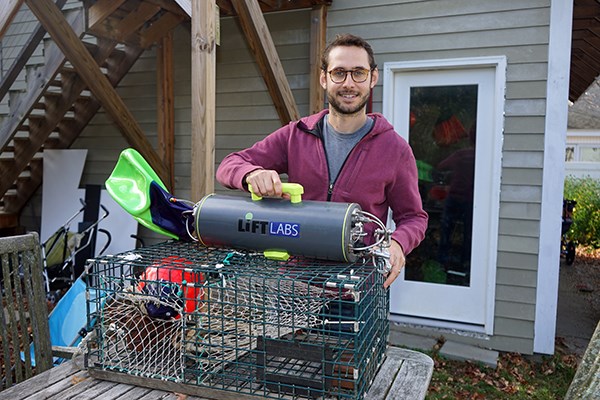 Image by Ed Brennen
Image by Ed Brennen
With his startup LiftLabs, plastics engineering alum Cormac Hondros-McCarthy '15 is developing a more advanced way to haul in lobster traps from the ocean floor.
12/06/2023
By Ed Brennen
Plastics engineering alum Cormac Hondros-McCarthy ’15 grew up on the water, spending summers at his family’s place in Bar Harbor, Maine.
When he and his dad would take their small sailboat out on Frenchman Bay, Hondros-McCarthy remembers their rudder sometimes getting caught on the lines for lobster traps sitting on the seabed some 300 feet below.
Fast-forward several years: Shortly after graduating from UMass Lowell, Hondros-McCarthy found himself in Malaysia, competing in an engineering prototype hackathon with a few co-workers from DEKA, a medical device company in Manchester, New Hampshire.
“We wanted to do some free-spirited engineering, so we applied, got in and took two weeks off for the trip,” he says.
The hackathon required teams to address one of five areas of ocean conservation. Hondros-McCarthy’s team chose to reduce “ghost gear” — the fishing nets, lines and traps that get lost at sea during storms. They came up with a rough variation of a ropeless lobster fishing system that utilizes buoyancy to bring the trap to the surface.
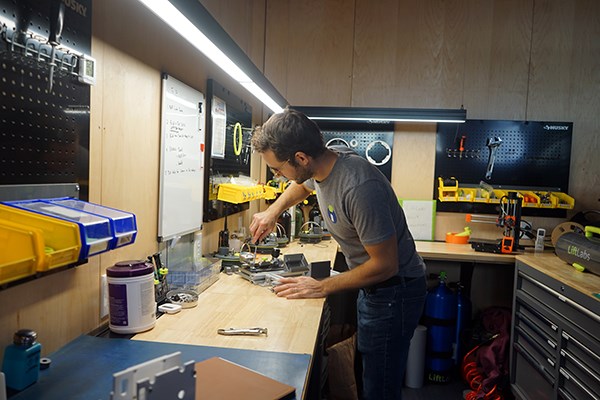 Image by Ed Brennen
Image by Ed Brennen
Cormac Hondros-McCarthy has received more than half a million dollars in grant funding from the National Oceanic and Atmospheric Administration so far for his ropeless lobster fishing solution, LiftLabs.
Their prototype won the $4,000 first prize — and it was the start of a ropeless fishing journey that sparked the interest in the startup LiftLabs, which Hondros-McCarthy now owns and operates in his hometown of Lowell.
“When you take a step back, it’s really gratifying to be doing this every day,’” Hondros-McCarthy says while giving a tour of his two-story workshop, which he built in the detached garage behind the house where he lives with his wife, Maureen, and their 2-year-old son.
Hondros-McCarthy began working on LiftLabs six years ago. After getting three grants from the National Oceanic and Atmospheric Administration (NOAA) totaling $514,000, he quit his senior manufacturing engineer job at FLIR Systems in North Billerica, Massachusetts, in 2021 to devote all his time to his idea.
Two of the NOAA grants are from its Bycatch Reduction Engineering Program, which aims to protect sea life that is caught in fishing gear. In the case of lobster fishing, it’s to protect the North Atlantic right whale, one of the world’s most endangered large whale species, with fewer than 350 remaining. Hondros-McCarthy says more than 80% of the whales have entanglement scars from fishing lines.
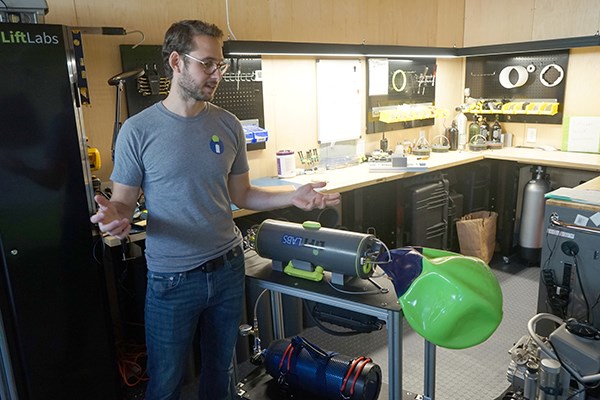 Image by Ed Brennen
Image by Ed Brennen
Cormac Hondros-McCarthy demonstrates how the LiftLabs tank inflates a balloon to bring the lobster trap to the ocean's surface.
Hondros-McCarthy, whose sister Ianna earned a psychology degree from UML in 2012, originally enrolled as a mechanical engineering major. He switched to plastics engineering, partly at the suggestion of his uncle, Stephen McCarthy, a professor emeritus in the department.
“UMass Lowell provided a strong basis to get started” on LiftLabs, says Hondros-McCarthy. “Everybody, especially in the College of Engineering, feeds off of each other, learning the basics of what it takes to break down a problem and get to the first principles — how does this work at the most basic level? That’s the main thing you learn in engineering: Don’t be afraid at the start of a problem. What’s the first part I can solve, then what else can I solve?”
Hondros-McCarthy was among the first students to participate in UML’s Rist DifferenceMaker Program. He and fellow plastics engineering major Casey McRae ’15 won the $4,000 first prize in the Innovative Technology Solution category for their 3D-printed Masela Dentures.
“I’m not sure that I would have taken on the endeavor of doing a startup of my own were it not for my DifferenceMaker experience,” Hondros-McCarthy says.
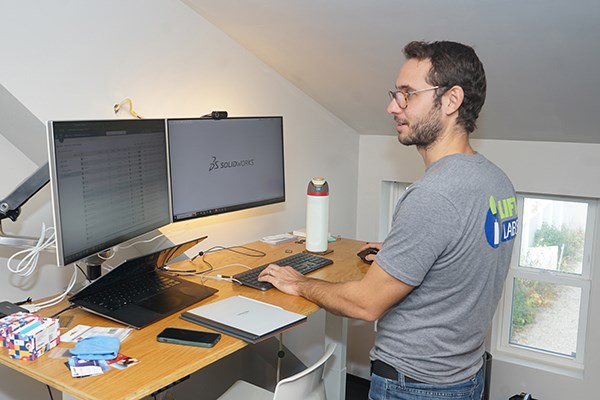 Image by Ed Brennen
Image by Ed Brennen
"I'm not sure that I would have taken on the endeavor of doing a startup on my own were it not for my DifferenceMaker experience," says plastics engineering alum Cormac Hondros-McCarthy.
“I would have jumped at something like this when I was looking for internships,” says Hondros-McCarthy, who completed two co-ops as a student and was also a member of the River Hawk Racing team. “A lot of our stuff is 3D printed and we’re always making changes, so there’s plenty of things to learn.”
LiftLabs is part of an accelerator program for startups at Dassaults Systèmes in Waltham, Massachusetts, where Hondros-McCarthy has free access to computer-aided design modeling software in the 3D Experience Lab.
While there are several other companies that make ropeless lobster fishing systems, Hondros-McCarthy hopes LiftLabs’ innovative technology and lower price point will help it catch on in the industry.
The device, about the size of a fire extinguisher, attaches to the top of the lobster trap and features an acoustic communication system. When a lobsterman want to bring a trap to the surface, they send a signal via an app on their phone. A compressed air tank then inflates a balloon, which lifts the trap. The tank can then be refilled on a docking station aboard the boat.
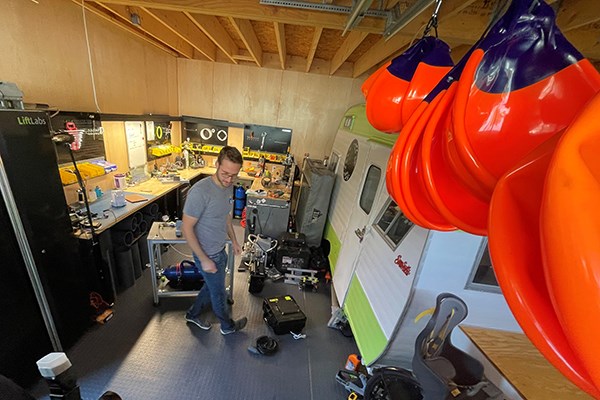 Image by Ed Brennen
Image by Ed Brennen
Cormac Hondros-McCarthy shares the first floor of his LiftLab space with his wife Maureen's Plantiful Food Trailer, which sells vegetarian dishes around the area.
“The goal is to make it a closed-loop system that’s simple and easy to operate,” says Hondros-McCarthy, who hopes to get the cost of a unit below $1,000 — a price tag that could be offset by federal subsidies. Some ropeless systems on the market cost more than $4,000, he notes, while traditional rope and buoy traps cost around $150, with around 20% of them lost during storms each year.
“We haven’t lost any of our gear to date,” says Hondros-McCarthy, who has worked with Scott Fulmer, a research professor in the Department of Biomedical Engineering, on the safety of the LiftLabs system.
“Lobster fishing is one of the most injury-prone professions. The traps are heavy, and the boats are moving around. There’s ropes tangled on the deck that can drag people overboard,” Hondros-McCarthy says.
He has tested around 30 LiftLabs systems with lobstermen, including a recent group in Halifax, Nova Scotia, and the feedback has been positive, he says. He has been garnering media attention for his work and hopes to have LiftLab systems on the market in the next few years.
By adding additional sensors to the system, Hondros-McCarthy says it could provide data on ocean conditions such as temperature, salinity and oxygen content, which lobstermen could use to find more profitable areas for their traps.
“That will be fun to work on collecting the data,” Hondros-McCarthy says. “It’s so difficult to get that information from the bottom of the ocean. It’s this world of its own down there.”
